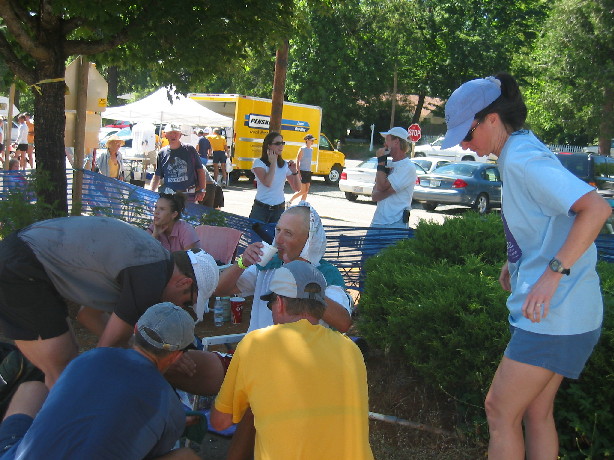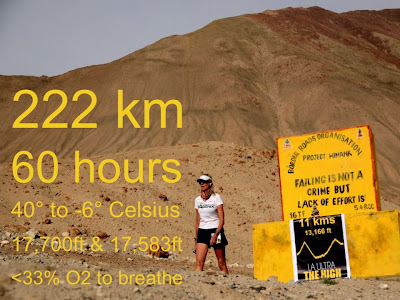La Ultra - The High, world's highest altitude ultra marathon, held in Leh - Ladakh, Jammu & Kashmir, India, August 2-4, 2012
Since I got invited last January to be part of a three man team to crew for my friend who is doing a 222 kilometer high altitude ultra race for 60 hours, yes it's 222 kilometers, this coming August, I get my butt crazy preparing for this event. Literally, I join what ever races there is in order to prepare for me physically, most of it are ultra races. Others don't understand my drive to join from one ultra to the other, why do such, others call it crazy cool, but really it is for this event that I want myself to be prepared. I am not the one who will be racing but I feel I need to be prepared for it, to be worthy of the invitation being offered to me and worthy of being part of the tough big race as a crew. This is one aspect of the race that is within my control, my being physically fit come the race proper.
The altitude of the place and how my body will react to it is something I cannot control , something I cannot prepare early on, I do not know how my body will react by then, I just hope my few high altitude climbs has prepared my body to be familiar to the thin air. And how things will progress on the race proper, how our runner will be and how we will be performing as a crew to be of best service to our dear runner, given the condition, the weather, this I really cannot figure out and cannot get a clear picture how it will go. I want to be of best service to my friend on this event, so aside from my physical preparation, I did several research of past races hoping that I will be able to get a clearer picture how it will go. This will be my very first time to crew an ultra event.
Few days ago, I come across this great article about being a crew, not on the same event though, but more or less it gives me an idea how to do it. Keeping a copy as my reference.
Crewing a Western States Runner
Guest Post By Laurie Thornley
So, you’ve volunteered to crew for Western States. Now what? Don’t panic. It’s actually a relatively simple process. If your runner has done his job, he will have provided you with adequate instructions for what he expects. All you need to do is follow his instructions, show up when and where he expects you to be, with what he expects you to have, and be present and attentive. Sounds easy enough, right? It can be, if you take some time to prepare.
First and foremost, be sure to read the Western States Participant’s Guide. It contains lots of useful information, including important rules for crew so you don’t get your runner disqualified, detailed maps and directions so you don’t get lost, and excellent descriptions and troubleshooting recommendations for some of the more common ailments your runner may face. And, make sure either you or your runner brings it to the race.
 |
| The Splits |
Know your runner’s plan. If he has target splits, make sure you know what they are so you can be ready and waiting for him at each aid station. Also, be prepared to adjust if your runner gets off his plan. For example, keep track of the time of day so you can anticipate if he may need additional clothing or lights sooner than he originally planned. Craig gives me his estimated splits in time of day, not elapsed time. For instance, he expects to arrive in Foresthill at 4 pm (not 11 hours). This makes it much simpler late in the race when the brain starts getting soft.
Have your own plan too. My plan is based on crewing for a fairly fast runner (sub 20-hour). Your experience may differ, but you may still find some of this information helpful regardless of how fast your runner may be.
If you won’t be returning to Squaw Valley after the race, check out of your hotel/condo before heading to the start so you can head down the mountain as soon as the runners have started. While there is plenty of time to get to Robinson Flat before the runners start coming in, I like to get there early enough to park at the top and avoid the shuttle.
Do all your shopping for both the runner and the crew the day before, so you don’t have to stop in Auburn for anything except gas and ice. For Craig and crew, our shopping list usually includes Pepsi, Mountain Dew, V8 juice, bread-turkey-cheese-avocado for sandwiches, bananas, grapes, melon, Pringles, pretzels, nuts, M&Ms, and of course Craig’s secret fuel: pork & beans. I like to bring Tupperware containers so I can prepare the sandwiches and melon ahead of time and keep them fresh. And, don’t forget lots of water for drinking AND DOWSING both runner and crew. It’s a long, grueling day, so it’s important to take care of yourselves as well as your runner. Toddlers and dogs are particularly susceptible to the heat, and should be monitored for signs of dehydration and overheating. Pacers especially need to eat and stay hydrated during the day so they’re not depleted when it comes time for them to run.
Be sure you have a full tank of gas before heading up the Foresthill divide. While Foresthill does have gas stations, I find it much easier not having to worry about gas for the rest of the day.
Have both a large cooler and dry aid box that you leave in the car and a smaller cooler and aid bag that you carry to the aid stations. You can restock the smaller containers from the larger ones before heading to each aid station. Backpacks make good aid bags. We also have a soft-sided cooler bag with a shoulder strap. Both are easy to manage, especially on the 3 miles down to the river (hint: wear comfortable hiking shoes).

Crew At Work
Bring a lightweight folding chair and ground cloth so you can set up your aid spot and have everything out, visible, and in reach every time. Besides food and electrolyte drink, you never know when your runner is going to need gels, S-caps, ibuprofen, sunscreen, Tums, Vaseline, Band Aids, baby wipes, flashlight, batteries, etc. or a fresh bandana, shirt, shorts, sunglasses, socks, hat, shoes, etc. Often just seeing an item out will prompt a runner to use it. If saving time is important to your runner, having two sets of bottles may help. That way you can swap them out instead of having to refill a single set each time. Also, if you have the luxury of multiple crew, it usually works best if you assign each crew member to a different set of related tasks (e.g., one person to manage bottles and fluid intake, another person to track food and pharmaceutical intake and go through the check list of possible fanny pack replacement needs, and a third person to deal with physical needs like massage, ice rub downs, blisters, chaffing, sunburn).
Always restock your smaller aid station cooler with fresh ice each time so you have ample ice to put in water bottles, rub on your runners legs, or put in his hat. Separate zip lock bags keep ice designated specifically for water bottles from getting grimy. I also keep a small hand towel soaking in another zip lock bag in the cooler so we always have a VERY cold towel to drape over Craig’s head and shoulders.
Bring lots of different clothing options. Robinson Flat, Dusty Corners, and Michigan Bluff can be blisteringly hot while the river and Hwy 49 crossing aid stations are always damp and cold once nightfall sets in. Bring extra lights and batteries for yourself as well as your runner. And bring the necessary comforts to the finish line for both runner and crew (e.g., a warm change of clothes and loose fitting shoes or sandals for your runner and sleeping bags and pads for everyone). You might even consider bringing a tent.
Have a pad of paper and pencil so you can keep track of the competition and report out to your runner how close he is to the next few runners in front of him. This becomes especially important toward the end of the run when the racing really begins as it helps to gauge if your runner is gaining or losing time to other runners. If he is close to someone at Hwy 49, you may also want to go to No Hands and Robie Point to give him additional updates. If you have failed to get times for previous runners, DON’T GUESS at the number of minutes ahead they are. Just get accurate numbers at the next aid station.
Understand the Psychology
Be prepared for a myriad of runner emotions throughout the course of the day, and don’t take any of them personally. Your runner will be alternately hot, tired, elated, dejected, sick to his stomach, catching a second wind, hungry, thirsty, and generally in pain somewhere. Do your best to address his needs, troubleshoot issues, and remain realistically positive. Unless your runner is physically injured, don’t allow him to contemplate quitting. Nausea, blisters, heat, and sleep deprivation will all conspire to challenge his resolve, and your permission may be all the excuse he needs to quit. Don’t offer this as a solution to those problems. If you are the type who doesn’t like to see others suffer, you might have to work hard at this.
Also be sure to take care of your own physical and emotional needs. It’s going to be a long day and night with hours spent in the car followed by more hours sitting at aid stations punctuated by mere moments with your runner. Try not to let it show when you get hot, tired, or stressed. He has worked very hard and invested a lot of time preparing for the race, and he is counting on you to be focused on him. Don’t burden him with your problems. He’s got enough on his mind.
Enjoy the Day
Finishing WS is a big accomplishment for both runner and crew. Take the time to enjoy it. Definitely take pictures. Hang out at the finish line. Attend the awards ceremony if you can. Talk to other runners and crews. Learn their stories. Share yours.

No comments:
Post a Comment